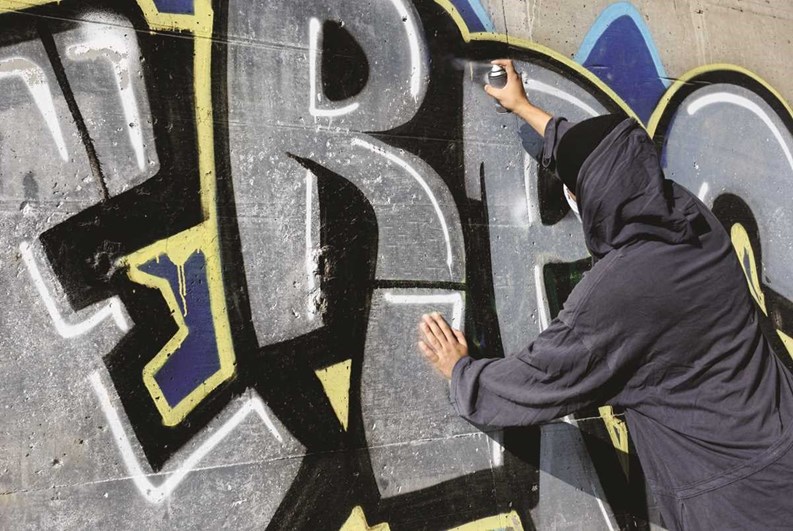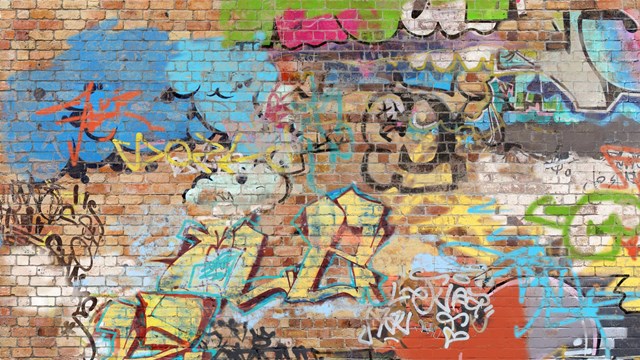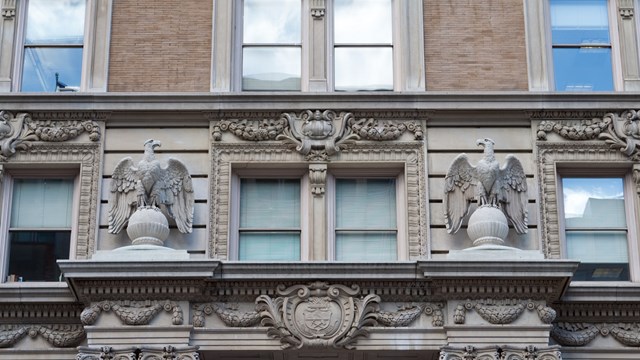While nowhere near as prevalent as it was in the 1980s (when it seemed as if one couldn’t find a clean wall in the city), graffiti has never completely disappeared from New York...or any metro area, for that matter. It seems to have become an acceptable part of urban life and a unique art form to some.
According to an analysis of 311 hotline data by amNewYork, graffiti complaints were up 16% for the 12-month period from November 1, 2013 to October 31, 2014, rising to 15,539 (from 13,366) across the city.
“When you ask people on the street about graffiti, they say ‘what graffiti?’ ” says Ed Talmo of Enviro-Northeast Sales Corporation, a distributor of anti-graffiti products, in Highland Lakes, New Jersey. “It’s become an acceptable part of city life,” perhaps receding into the background of the urban landscape.
The Oxford Dictionary defines graffiti as “writing or drawing scribbled, scratched, or sprayed illicitly on a wall or other surface in a public place.” Most of it is “tagging,” a name spray-painted on a wall, often put up in lightning speed. But, according to Nicholas LaSorsa, owner of the Astoria-based Hudson Power Washing, “almost all graffiti in the city is ‘tagging,’” which, he says, “is just a term for somebody getting their name up really quick.”
While most of the graffiti images in New York are tags (the writer’s signature rendered in marker or paint), other forms include the “throw-up” or “fill-in” painted with an outline color and a fill-in color, and the “piece,” short for masterpiece, a large, elaborate, colorful mural.
While graffiti is thought to be an inner city phenomenon (lower income areas do indeed have more than their share of defaced properties) and often associated with gang activity, these thoughts are not entirely accurate. In fact, some gentrified neighborhoods are targeted, as well, and only a small percentage of graffiti is perpetrated by gangs marking territory.
Getting into the head of a tagger is not difficult; no doubt, graffiti is—to some extent, an expression of boredom, anger, and frustration. In a small number of cases, graffiti makes a political statement or—at its ugliest—spews hatred. Most graffiti is the product of kids looking for attention, and the areas they choose are those with the most eyeballs.
“It is not the amount of disorder that determines a good spot to write graffiti, but the number of potential viewers and the unlikelihood that the graffiti will be painted over,” writes Gregory J. Snyder, a Baruch College sociologist in “Graffiti Lives: Beyond the Tag in New York’s Urban Underground.”
“These spots tend to be where young people from all over the city are likely to congregate; thus, the East Village, Lower East Side, and Soho are where most New York City graffiti is found. These are not poor, crime-ridden neighborhoods.”
Out Now, Damned Spot
Once a building is hit, experts recommend removing graffiti immediately. Not only is it a jarring and demoralizing sight for apartment owners and guests, it discourages prospective buyers and attracts the ire of neighbors. If left overnight, graffiti may very well beget additional graffiti.
“More than likely,” says Talmo, “if somebody puts a tag on, history tells us that if it goes untreated, they will come back and put it on again. The key to having a successful graffiti free building is to tune in every morning and if you see graffiti on your structure, remove it immediately, so that kids don't get a chance to see it.”
Additionally, stick with the program, even if the vandals return a few times. “That can go on for a while,” says Talmo. “It becomes a battle of wills. But if they don't get to see it, they will soon move on to other structures that are not maintained so well.”
In practical terms, the most important reason to act fast is that, “the longer it stays on a structure, the harder it is to remove,” says Talmo. “Some substrates, like limestone, once it gets into the white soft stone, it's almost impossible to get out.”
Building staff can take a stab at removing graffiti themselves but most are ill-equipped. “Probably 75% of the graffiti removal jobs I do,” says LaSorsa, “somebody tried to get rid of it with the chemicals they bought at Home Depot and are not successful. I usually just see the ink smeared around.”
Fortunately, he says, “they usually don’t damage the building, because they are not using a high pressure machine.” If vandals do manage to get their hands on a high-pressure washer, he adds, “they can damage masonry pretty easily. If you don’t know what you are doing, you can definitely scar the brick permanently.”
The Tagger’s Toolkit
Graffiti writers use paint almost exclusively, dispensed from an aerosol spray can, which offers speed and portability. If you’re lucky, the tagger used a water-based acrylic, which washes off fairly easily. Most use oil-based spray paint, which is harder to get off. Epoxy-based paint is the worst. “It’s a nightmare,” says Jack Kobe of the Greenpoint, Brooklyn-based Marble Lite, Inc. On limestone, especially, he says, “it always leaves a mark. You can get it out with a sand blaster…but when it’s wet you can see the mark.”
New York City offers a free graffiti removal service, as part of the Graffiti-Free NYC program, administered by a partnership from the New York City Department of Sanitation (DSNY) and the city’s Economic Development Commission. The program sends fully-equipped, anti-graffiti trucks around the city in response to 311 calls by building owners and managers. Since its inception in 1999, the program has cleaned nearly 83,000 incidents of graffiti.
The problem with the program for residential buildings is that, as often with city services, notes LaSorsa, “the response time is not appropriate for a lot of places. Co-ops don’t want their residents looking at it. They want it done right away and don't have time to wait three months for the city to show up.”
The easiest and cheapest solution is to paint over the graffiti, and it might be tempting to slap paint on the back or sides of the building, which are not visible to the public. Talmo advises against it. For one thing, he says, “non-breathable coatings trap the moisture. Over a few years you have freeze-thaw cycles. The moisture in there can't get out, and starts breaking down the capillaries in the mortar.”
Also, a freshly painted wall welcomes back the taggers. “It's like giving them a brand-new canvas,” says Talmo.
Getting it Out
The graffiti removal process is a variation on two themes: loosening the paint and blasting it off with pressurized water, sand, or baking soda.
There are a wide range of chemicals specially designed to attack graffiti on the market, most with colorful, catchy names, like Elephant Snot, Taginator, Sludgehammer and those made by World’s Best Graffiti Products, available in a variety of formulations to treat different types of surfaces, including sensitive, historic stone and brickwork and masonry.
Most of the popular products are biodegradable. A few are said to be made with natural ingredients exclusively, such as citrus juices. Though, there are no official green standards; they are self-certified. “There is a lot of snake oil within the industry,” Talmo claims. “Manufacturers telling people that their products were breathable and they really were not. There is no standard.”
He likes the old standbys. “Some of the harsh older chemicals seem to work the best. If you have both potassium hydroxide and methylene chloride paint strippers on a vehicle, and you go to remove graffiti, you can get off most pigments.”
If you put up a protective coat after removing the graffiti, he insists, “there's nothing more green and environmentally safe then using these heavy-duty chemicals one last time to clean it. Put the barrier up and go back to a biodegradable cleaner for years and years and years.”
Blast Off
Spraying the loosened paint off is the next step. Here’s where the expertise comes in. “I don’t want to say this is an art,” says LaSorsa, “but you have to know the right amount of pressure to use.”
The most common method is power-washing the wall with a 3000 psi-pressure washer spraying 250-degree water, using the appropriate nozzle tip for the job. Too narrow of a spray can scratch the masonry surface.
Applied after allowing the chemical solvent to settle into the surface, power-washing will completely remove the graffiti in most cases. Some surfaces like stone or soft brick will require sand-blasting or soda-blasting, a newer alternative to sand-blasting that uses baking soda.
Talmo recalls a school he worked on in Manhattan. “The base was limestone and we had to use a baking soda blast to remove the graffiti,” he says. Sadly, though the graffiti was removed, he says, “basically we put a new profile on the stone. It changes the appearance. You lose a lot of the beauty.”
Anti-Graffiti Coatings
If your building is hit more than once, you should consider putting on a paint-resistant coating, which prevents graffiti from bonding to surfaces. There are two types of anti-graffiti coatings. The sacrificial coating lays an easily-removed clear barrier over the surface. If the wall is tagged, the coating can be removed using a high-pressure washer, taking the graffiti with it. The coating, which is an inexpensive clear polymer, must then be reapplied to repel repeated tagging.
Permanent coatings, which create a protective surface which paint cannot bond to, are more expensive, but only have to be applied once. Often made from polyurethane or fluorinated hydrocarbon (which is particularly effective in repelling spray paint), permanent coatings can be washed free of paint with a simple solvent and a hose or low-pressure power-washer.
Fortunately, graffiti rarely appears on the inside of the building. “Indoors,” says Kobe, “you have cameras and security.” If it does, however, he adds, “you don’t need the heavy equipment.” Metal surfaces—which do not absorb paint—can be wiped down with a common paint thinner and rubbed with steel wool or sandpaper. Wood can be wiped down with mineral spirits. The best way to remove painted graffiti from glass is to scrape it off with a razor blade or apply paint thinner.
If your building is hit by the infamous Banksy on his next flash tour of New York City, mount a thick sheet of protective plexiglass on the work and call Sotheby’s. If the graffiti writer is of any less renown, remove it immediately and put up a protective barrier against future artistic intrusions.
Steve Cutler is a freelance writer and a frequent contributor to The Cooperator.







Leave a Comment